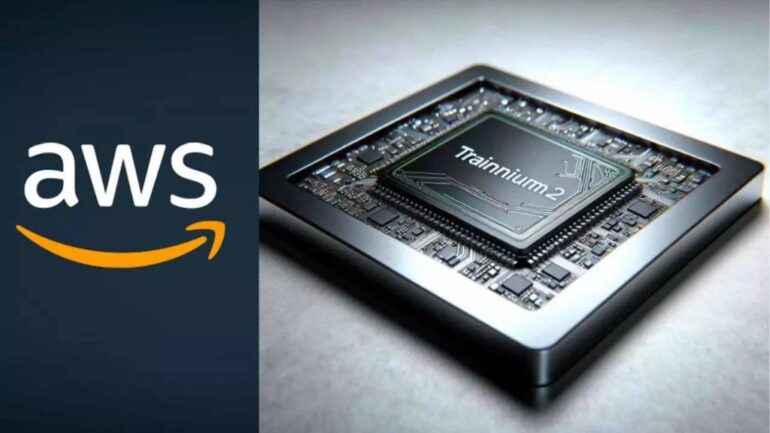TL;DR:
- AWS unveils Trainium2 chips for model training with 4x better performance and 2x energy efficiency.
- Graviton4 processors offer 30% performance boost and lower energy consumption for AI applications.
- Amazon solidifies its partnership with NVIDIA, providing cloud access to H200 AI GPUs.
- Introduction of AI chatbot “Q” for business-focused tasks, tailored to various industries.
- Q integrates with popular communication and software platforms, with pricing ranging from $20 to $30 per user per month.
- Amazon competes with Microsoft for supremacy in enterprise-based AI and reinforces its position in cloud computing.
Main AI News:
In the bustling world of technology, Amazon Web Services (AWS) has commenced its grand Las Vegas-based re:Invent conference with a cascade of revelations, firmly rooted in the realm of artificial intelligence (AI). These unveilings collectively provide us with a glimpse into the company’s enduring aspirations within the domain of artificial intelligence platforms.
Foremost among these announcements is AWS’s introduction of its cutting-edge AI chips, meticulously crafted for both model training and executing trained models. Enter Trainium2, explicitly tailored for model training, bearing the promise of delivering a staggering fourfold surge in performance and twofold enhancement in energy efficiency, juxtaposed against its predecessor. Amazon’s assurance lies in these chips’ ability to empower developers to expedite model training while curtailing costs through reduced energy consumption. Notably, Anthropic, a contender backed by Amazon and a rival to OpenAI, has already laid out plans to harness the potential of Trainium2 chips for their own model-building endeavors.
On the flip side, we encounter Graviton4, which was designed with versatility in mind. These processors are rooted in the Arm architecture but exhibit a penchant for frugality when it comes to energy consumption, outclassing Intel and AMD counterparts in this regard. Amazon sweetens the deal by vouchsafing a 30% boost in general performance when a trained AI model is set to operate within a Graviton4 processor. This not only augurs well for organizations perpetually engaged with AI models but also promises a slight acceleration for casual users indulging in whimsical pursuits, such as conjuring up faux images of Harry Potter reveling at a rave.
Collectively, Graviton4 holds the promise of enabling AWS clientele to process copious volumes of data, scale their workloads, expedite time-to-results, and concurrently lower the total cost of ownership. As it stands, Graviton4 is available for preview, with a more extensive release slated for the imminent months.
Traditionally, when a corporation introduces proprietary in-house chips, it tends to sound the alarm for incumbent third-party providers like NVIDIA. NVIDIA’s substantial presence in the enterprise AI arena, thanks to its GPUs being widely adopted for training purposes and its Arm-based datacenter CPU Grace, potentially faces disruption. However, Amazon is taking a different route by fortifying its partnership with NVIDIA. They offer enterprise clients the privilege of cloud access to NVIDIA’s latest H200 AI GPUs. Furthermore, Amazon commits to managing over 16,000 Nvidia GH200 Grace Hopper Superchips explicitly for NVIDIA’s research and development endeavors. This strategy mirrors that of its principal AI adversary, Microsoft, which concurrently reinforced its alliance with NVIDIA while unveiling its proprietary AI chip, Maia 100.
Additionally, Amazon introduced a novel AI chatbot explicitly catered to the business landscape, christened “Q” – a moniker seemingly inspired by the iconic Star Trek entity rather than any unsavory associations. Q is hailed as a “novel breed of generative AI-powered personal assistant” meticulously designed to streamline work projects and augment customer service operations. This versatile digital entity can be tailored to align with the unique requirements of any business, proffering pertinent responses to frequently posed queries. Beyond this, Amazon Q has the remarkable capability to generate content autonomously and execute actions based on customer requests. Furthermore, it adapts its interactions in consonance with the user’s role within the corporate hierarchy.
Q finds its abode in communication platforms like Slack and text-editing applications commonly frequented by software developers. Notably, it possesses the capacity to modify source code and interfaces seamlessly with over 40 enterprise systems, including but not limited to Microsoft 365, Dropbox, Salesforce, and Zendesk, among others. As of now, Amazon Q is accessible for preview, with a more extensive release slated for the imminent future. Its pricing structure ranges from $20 to $30 per user per month, contingent on the array of features availed.
Conclusion:
Amazon’s comprehensive AI advancements and strategic alliances signal its commitment to dominating both the enterprise-based AI and cloud computing markets. By offering cutting-edge AI chips, strengthening ties with NVIDIA, and introducing the versatile AI chatbot “Q,” Amazon aims to outpace competitors like Microsoft and secure its position as a leader in these ever-evolving sectors.

